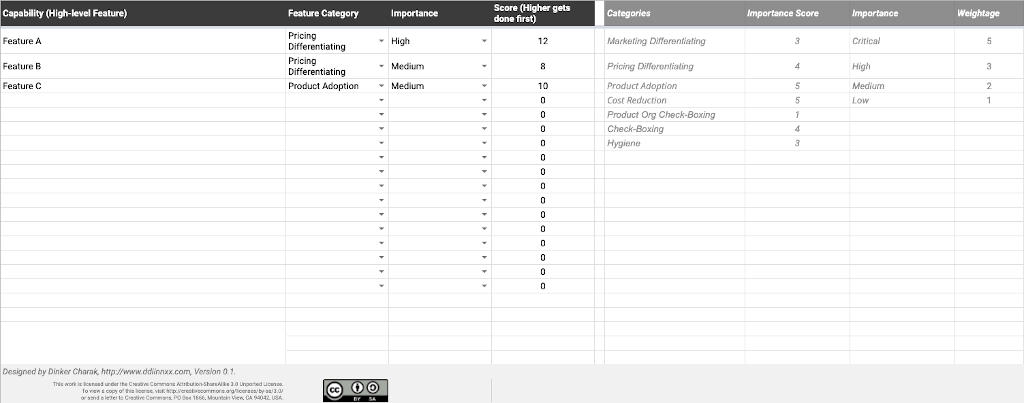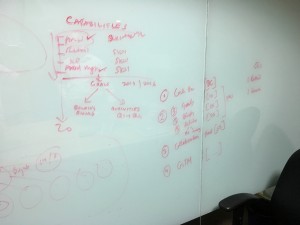1. Ground Rules
1.1 Prep
The Rubrics Based Approach for feature prioritisation expects that you already have a list of features. While using the Rubric, sometimes other aspects are brought to light. These are some aspects you have overlooked or ignored. Feel free to consider them and add features related to them.
1.2 Keep Features at the Same Level of Granularity
The term Product Feature often lends itself to some ambiguity. There might be some confusion on how fine-grained a feature should be for this rubric. My recommendation is to keep them at the same but high level of granularity.
2. Building the Rubrics
2.1 Step 1: Decide on the Product Feature Categories
Most Product Features belong to one of the following categories. As you read through them, you may realise there are one or two that I have missed. That is OK. Arriving at this list is the first step. The categories are:
Marketing Differentiating: These are the set of features that differentiate your product in the market, especially for the users and promoters.
Pricing Differentiating: These are the set of features that a customer will pay extra for or make your product cheaper.
Note: There is a subtle difference between market and pricing differentiation. The market differentiation helps your product to stand out so the customer picks your product over other similar ones. However, if you want the customer to pay a little extra, the pricing differentiators kick in.
“Our toothpaste has salt in it,” is a market differentiator. “Our toothpaste tube is 100% biodegradable” is a pricing differentiator for a responsible buyer.
Product Adoption: These are the set of features that ensure there is least resistance path to adoption, recommendation and invitations to other users.
Cost Reduction: These are the set of features that reduce the cost of building, maintaining and evolving a product.
Product Org Check-Boxing: These are the set of features that the organization want to be part of the products they produce. typically, these tend to cross-promotion of other products, features that ensure smooth interoperability between products that are part of the same suite, etc.
Market Check-Boxing: These are the set of features that tend to not so very useful and common ask when selling to Enterprises. These are features that do not bring a lot of value to users. These tend to be needed for passing eligible paperwork or to not stand out as having few / missing features as compared to the competition.
Hygiene: These are the set of features that are the ‘cost of running a business’. These will include say, Sign-up / Sign-In, Profile management, delete the account and other features that are essential, non-differentiating and present across all other products in the domain.
2.2 Step 2: Assigning Importance Score to Product Feature Categories
Not all of the above categories may be applicable to your product at the stage it is and that is OK. The rubric will help you incorporate that into the prioritization process.
First, ensure you are aware of the answers to the following questions:
- Do you know the goal of your product? Is market differentiation one of those goals? Is being premium or cheaper than the competition a goal? Is viral spread or fast adoption such a goal?
- Do you know the goal of the organization?
- Do you know the goal of your customers?
- Do you know the goal of your users?
Based on the above, you should be able to assign a score to the Product Feature Categories. The following set of examples assign a score from 1-5.
A startup that is focused on market penetration:
| Marketing Differentiating | 5 |
| Pricing Differentiating | 2 |
| Product Adoption | 5 |
| Cost Reduction | 2 |
| Product Org Check-Boxing | 1 |
| Market Check-Boxing | 1 |
| Hygiene | 3 |
An Enterprise Software company:
| Marketing Differentiation | 3 |
| Pricing Differentiation | 4 |
| Product Adoption | 5 |
| Cost Reduction | 5 |
| Product Org Check-Boxing | 1 |
| Market Check-Boxing | 4 |
| Hygiene | 3 |
2.3 Step 3: Assigning Importance Score to Product Feature within the Category
Now that you have assigned importance to the product category, you need to assign importance to a feature over others within that category. Usually, the following works:
| Critical | 5 |
| High | 3 |
| Medium | 2 |
| Low | 1 |
3. Calculating the Score & Prioritization
Consider this simple approach:
The product of the category score and the feature’s score is the score. Eg: for the enterprise software company we considered above:
Feature A that brings Pricing Differentiation (score 4) and is deemed high (score 3) will have a score of 12.
Feature B that brings Pricing Differentiation (score 4) and is deemed medium (score 2) will have a score of 8.
Feature C that brings Product Adoption (score 5) and is deemed medium (score 2) will have a score of 10.
So the prioritization will be:

A, C and then B.
4. Get the Sample Google Sheet
This one includes formulas to get you going immediately:


